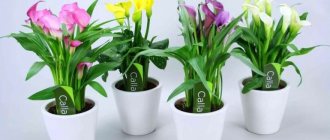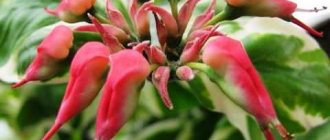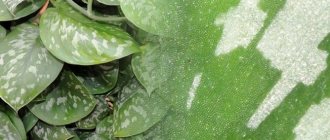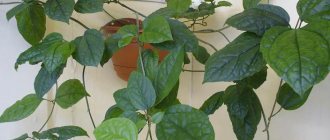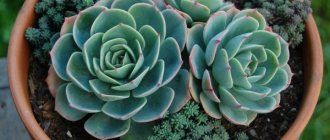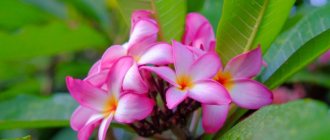Brief description of cultivation
- Illumination . Requires bright light, but should avoid direct sunlight.
- Temperature . During flowering, it is necessary to maintain the air temperature within 20-25°C. During the rest period – 13-15°C.
- Bloom . It begins to bloom in early June and ends in the first weeks of autumn.
- Watering . Abundant, after the top layer of soil dries.
- Air humidity . It must be high, this requires constant spraying. In winter, you need to remove the plant from heating appliances.
- Feeding . Conducted from mid-April to the end of the summer.
- Rest period . After flowering, that is, autumn-winter time.
- Trimming . When the flower begins to actively grow.
- Transplant . At the beginning of the growth period, a young bush is replanted once a year, an adult - once every three years.
- Reproduction . Seeds and cuttings.
- Pests . Spider mites, aphids, whiteflies, scale insects.
- Diseases . Chlorosis, rot.
Why doesn't Thompson's clerodendrum bloom?
Various magical properties are attributed to clerodendrum, explaining the absence of buds as negative energy. But, of course, the reasons are more prosaic and lie in violation of the rules of plant care.
- Volkameria will not bloom if it has not spent a dormant period in a cool place. At a constant temperature, the plant has no reason to form flower stalks.
- Dry air is regarded by the flower as unfavorable conditions. To stimulate flowering, daily moisture is necessary.
- A cramped pot inhibits the root system, and in clerodendrums it is very delicate and vulnerable. A young plant needs to be replanted annually, increasing the volume of the container by 2-4 cm. With sufficient space, the flower develops harmoniously and is full of strength for new flowering.
- Lack of sunlight is also regarded as a threat and leads to the discarding of already collected buds.
- Excess nitrogen in fertilizers redirects nutrients to the growth of green mass, leaving no energy for buds.
- The plant loves moisture, remembering at the genetic level the humid tropics. But regular overwatering is not beneficial, but leads to the development of root collar rot and damage to the roots. In this case, clerodendrum is definitely not up to flowering.
- If there is no or insufficient drainage layer, waterlogging occurs and the plant will also refuse to form buds.
One of the most important conditions for the flowering of Thompson's clerodendrum can be considered timely pruning at the very beginning of the active growth phase. This is the only way to give the volkameria the desired shape, remove excess green mass, redirect life-giving juices to the flower buds and save the plant’s strength.
One of the most important conditions for the flowering of Thompson's clerodendrum can be considered timely pruning at the very beginning of the active growth phase. © flora-toskana
Diseases and pests
Pests are rare, but are found on these indoor plants. It is difficult to notice them, but changes in the structure and color of the leaves should alert you. Along with a new flower from the store, spider mites and whitefly caterpillars may arrive.
Diseases rarely occur with proper care. However, changes in the color, shape and size of leaves, thinning of leaf blades and deformation of shoots indicate a lack of light and nutrients. But if these conditions are met, then you will have to remove the plant from the pot and inspect the root system.
When rot appears, the damaged part is removed with a sharp, disinfected knife, the roots are placed in a solution of potassium permanganate or the HOM preparation for 40 minutes, then the flower is transferred to a new pot and fresh substrate. The old soil can no longer be used.
Dear readers! In practice, I have become convinced that clerodendrum is not a capricious flower at all, all the conditions for its care are easily met and it is quite simple to induce it to bloom. My clerodendrum is once again going into hibernation after abundant flowering. It made me happy for almost 4 months.
It is believed that it can bloom almost all year round with a short break for winter dormancy. So far I have not been able to achieve this, which means there is something to strive for. If you have your own secrets for growing this amazing plant, please share your personal experience, I will be glad.
Home care
Clerodendrum is a tropical flower, so you need to create conditions for it that will be as similar as possible to natural ones. In its natural environment, clerodendrum grows twining around tree trunks, so it needs constant support. The plant blooms better if it is frequently pruned and pinched .
Illumination
The flower needs a lot of light, but direct sunlight should not fall on it, otherwise the plant will die. The best option for placement in an apartment would be windows on the west and east sides. If you place clerodendrum on the south side, shading is necessary to protect the flower from active sunlight.
The plant will not bloom on a window located on the north side, as there will not be enough light.
Temperature
The favorable temperature for flowering clerodendrum is 20-25°C in summer. And in winter it is recommended to move the plant to a room where the air temperature is about 15°C.
Air humidity
The flower absorbs moisture over the entire surface of the leaves and must be regularly sprayed with a spray bottle. Also, clerodendrum does not tolerate dry air , which is why spraying is so important. Melt or rain water is suitable for this.
Melt water can be easily made at home. What does this require? A plastic bottle is filled with tap water and placed in the freezer. After the water has completely frozen, remove the container and defrost it at room temperature.
Watering
Watering the plant should be done regularly.
You cannot overwater the flower, otherwise the root system will rot. Therefore, watering should be moderate when the top layer of soil dries . In winter, watering is done even less frequently, but complete drying of the soil should also be avoided.
Fertilizer
Fertilize the flower no more than once a week in summer and once a month in winter. Liquid fertilizers suitable for indoor plants are excellent. When the flowering period has passed, feeding should be stopped and resumed closer to mid-spring.
Budding and blossoming
Flowering begins in early summer and ends in the first weeks of autumn . In winter, the plant is moved to a cool place. During this time, the flower may completely or partially shed its leaves and expose its shoots. This is a completely natural process that you do not need to be afraid of.
With the onset of spring, the stems of clerodendrum are cut off by one third so that the plant begins to bloom and branch even better.
Why doesn't it bloom buds?
This may be a consequence of improper care of the flower in winter. Clerodendrum is a plant that is very important for rest and needs time to recover in order to bloom with renewed vigor. You need to prepare the flower for the dormant period in the fall, when the shoots begin to grow more slowly. At this time, the amount of watering decreases and fertilizing stops.
Trimming
Pruning is an important procedure for a tropical plant. This is necessary for the flower to be lush, beautiful and retain its shape. If you do not trim the flower, the stems will branch heavily and will need support .
Also, there will be few new shoots and there will be no lush bush. Pruning is usually carried out in the spring, when the flower is actively growing, the shoots are shortened by one third, and dried and weak branches are removed. You can form a flower in the form of a standard tree; for this, one strong shoot is left, then the side branches are removed from it. When the plant reaches a height of 50 cm, pruning is done and new shoots are pinched, so the tree will have a lush crown.
Transfer
The young flower is replanted once a year, increasing the pot each time. An adult plant - every three years.
The roots of the flower are very fragile and are replanted using the transshipment method.
A deep pot is required for replanting. A drainage layer of approximately 4-5 cm is placed at its bottom. Suitable for drainage:
- Red brick;
- expanded clay;
- gravel.
The substrate itself consists of:
- Clay soil.
- Leafy soil.
- Fine river sand.
- Peat.
Before planting , the soil is disinfected to protect the flower from pests and fungi that may accidentally enter the soil.
The benefits and harms of clerodendrum
The plant does not belong to the medicinal group, but the benefits of contemplating it are palpable. Look at a luxuriously blooming clerodendrum tree or bush, and a great mood and positive emotions are guaranteed. All parts of the plant are non-toxic, do not cause allergic reactions, and are therefore harmless to children and pets.
After reading the article, you are convinced of the need to have a plant at home. Every woman dreams of having a healthy, friendly family, and clerodendrum will contribute to this.
Reproduction methods
There are two methods by which clerodendrum reproduces well: growing from seeds and cuttings.
Growing from seeds
To grow from seeds, you can use store-bought seeds or collect them from an existing flower. Sowing is carried out at the end of February or beginning of March. The planting algorithm is as follows:
- The pot is filled with a mixture consisting of peat, sand and turf soil.
- Next, the seeds are evenly distributed on its surface.
- Then a small greenhouse is made and the container with the seeds is placed in a warm place with good lighting.
- It is necessary to regularly ventilate and moisten the soil.
With proper care, the first shoots will appear after 6-8 weeks. After 3-4 full leaves are formed, the seeds are planted in small containers or cups with drainage holes.
Propagation by cuttings
Cuttings begin in the spring; they are harvested when pruning the plant. Shoot cuttings are used as cuttings. The shoots are placed in a container with water and covered with polyethylene. After a while, roots will form on the cuttings, after which they are planted in the ground. But it is worth remembering that the roots are very fragile and weak, so you need to plant them very carefully so as not to damage them.
- First, arrange a drainage layer of 3-4 cm.
- Next, 1/3 of the pot is covered with the prepared substrate.
- The soil needs to be watered abundantly.
- Then the cuttings are carefully planted and soil is added in the required amount.
- The container with the cutting is covered with a glass jar or plastic bottle.
- The planted cuttings must be regularly watered and ventilated.
- The shelter is completely removed when the first leaves appear.
When the cuttings are completely rooted, they can be planted in the pots in which they will grow in the future.
The video shows propagation by cuttings:
Why doesn't clerodendrum bloom?
Spectacular, delicate, airy, inimitable - these are the epithets that come to mind when I admire the flowering of clerodendrum. He has been living with me for 4 years, but I just can’t get used to this miracle. A neighbor gave the flower when she moved. She didn’t tell me anything about him, assuring me that I would figure it out myself. I started looking for information and learned a lot of interesting things. In particular, there is a very beautiful legend associated with the flower, and it does not bloom in every home. I hasten to share with you the features of caring for the “tree of destiny”.
Why doesn't clerodendrum bloom?
Content:
- Clerodendrum - a flower for a good mood
- Growing conditions and care
- Methods for propagating clerodendrums
- Why doesn't Thompson's clerodendrum bloom?
Pests and diseases
If not properly cared for, the flower weakens and becomes susceptible to pests.
Pests
Spider mite
The pest can be detected by the presence of cobwebs on the stems and limp foliage . To combat ticks, use a soap solution. If the damage is severe, then chemical agents are used. For prevention, the air and flower should be regularly moistened.
Aphid
When affected by aphids, the plant stops growing, leaves and flowers become deformed and fall off. Infected areas need to be cut off and the flower treated with soapy water or an antifungal agent.
Whitefly
Whitefly larvae can usually be found on the undersides of leaves. The leaves will become deformed and fall off.
To combat whitefly, you need to remove the affected leaves and treat the flower with an insecticide.
Shchitovka
Signs of scale insects are small yellow dots on the leaves, which enlarge over time, and the leaves begin to fall off and dry out. If the parasite is not detected in time, the clerodendrum may die.
If there are few scale insects, they can be removed with a brush and treated with a soap solution. If the lesion is large, then chemical treatment will be required.
Why doesn't it bloom?
Clerodendrum does not bloom in the following cases:
- The rest period was organized incorrectly.
- The flower has been growing in the same pot for a very long time.
- Deficiency or excess of nutrients.
To eliminate the problem, you need to adjust the application of fertilizers, transplant the flower into a new container and ensure proper dormancy in the winter.
In winter, the flower should be located in a cool place. After flowering ends, watering is reduced and the flower pot is placed in a room where the temperature is maintained at +15. During the dormant period, the plant gains strength for future flowering, usually this period lasts 1.5-2 months until new shoots appear.
The leaves are turning yellow
If a flower begins to turn yellow in summer or spring, this indicates a lack of moisture in the soil . In this case, the plant must be watered more often and more so that there is always water in the pan. Chlorosis can also be the cause of yellow leaves; this can be eliminated by fertilizing with preparations containing iron.
The leaves are falling
If the leaves fall after flowering, then this process is natural. But if the leaves fly around in summer or spring, then it is worth reviewing the rules for caring for the flower. Maybe it is not watered correctly or the flower is in the wrong place.
Clerodendrum: how to make it bloom
Why do rose leaves fall off in summer - what to do
If there is a capricious clerodendrum in the house, the household must know how to make it bloom. If flowering does not begin, it is recommended to do the following:
- In the spring, take the flower pot into a cool room for 2-3 weeks.
- At the end of this period, cut off the shoots.
- Replant into new soil.
Pruning clerodendrum must be done correctly, otherwise you may deprive yourself of the opportunity to observe their flower inflorescences.
Trimming
Views from photos
Thomson (Thomsoniae)
A distinctive feature is flowering; red flowers with hanging stamens bloom against a background of white bracts. It blooms from early April to June, but with careful care it can begin to bloom in the fall.
Shiny (Splendens)
A green bush with climbing stems, leaves growing in whorls of 3 pieces. The inflorescences are scarlet in color and form dense racemes . With proper care they can bloom throughout the year.
Philippine (Philippinum)
It can reach a height of 2 m. The flowers are collected in a basket and resemble small roses, the edges of the petals are openwork. They have a pleasant, sweetish smell.
Ugandan (Ugandense)
It is a liana-like subshrub. The upper and lateral petals are blue, and the lower petals are purple. A feature of this species is the duration of flowering: faded inflorescences are quickly replaced by new ones. Grows well in open ground and can grow up to 3 in a few months.
Fragrant (Fragrans)
An evergreen shrub up to 2 m high. The flowers have a light pink hue and a special aroma , reminiscent of a mixture of citrus and violets. With good care it can bloom all year round.
Wallich or Prospero
Smooth-leaved evergreen shrub with white inflorescences and long stamens. It is also called the “bridal veil”. The branches of the bush are red-green with dark green oblong leaves. This species requires careful care, it needs a lot of light and high humidity.
Beautiful (Speciosum)
An evergreen shrub up to 3 m high. The inflorescences consist of small purple flowers. Heart-shaped leaves. Flowering period from early June to late September.
What can be done
If flowering is not observed, it is worth knowing what can be done to make the clerodendrum bloom. First of all, you should properly organize its wintering: reduce the amount of watering and lower the air temperature. But this should be done gradually immediately after the end of the previous flowering. It is necessary to water so that the plant does not dry out. Most often, this period lasts about 1-2 months. If the flower begins to produce shoots, you need to increase the number of waterings, move it to its usual place and begin to introduce fertilizers into the soil.
Transfer
Often a transplant is required for clerodendrum to bloom. The soil must be nutritious, and therefore it is worth monitoring its chemical composition. Before transplanting, it is necessary to disinfect the new substrate. To do this, you can use the oven or microwave.
The new container should be 2 cm higher and wider in diameter than the previous one. It is necessary to lay 2-3 cm of drainage at the bottom, carefully transfer the plant, trying not to damage the root system. It is necessary to fill the voids in the pot with a new substrate and water the flower.
Important! If the clerodendrum may subsequently require support, it is better to dig in the support during transplantation. Sticking it into the soil without damaging the roots is quite difficult.
How to create conditions for lush flowering
If a florist once sees how clerodendrum begins to bloom, he will subsequently want to refresh his impressions. For these purposes, it is worth learning how to properly care for a flower during this period. Diffused bright light is the most optimal lighting. The air temperature in summer should be in the range from 18 °C to 25 °C. It is also worth spraying the flower regularly, thereby increasing air humidity.
How to propagate a flower from cuttings?
The plant can propagate by seeds and cuttings. Planting cuttings is considered one of the most acceptable ways to obtain new specimens of this species, since getting them to sprout under artificial conditions will require a lot of time and labor.
To carry out cuttings correctly, you must:
- During spring pruning, prepare cuttings - they are side shoots with 3-4 leaf nodes. The cut is made at an angle of 45°, this will speed up the formation of the root system.
- Soak the cuttings in growth stimulants “Zircon” (1 g per 5 liters of water), “Kornevin” (1 g per 1 liter of water) or “Heteroauxin” (1 tablet per 5 liters of water). To do this, their 1–2 cm cut point is dipped into the working solution for 6–8 hours.
- Pour a mixture of turf soil, peat and sand (1:1:1) into a shallow garden container with a diameter of about 15 cm, and then moisten it well.
- Dip the cuttings (3-4 pieces per container) into a damp substrate, cover with thick transparent polyethylene and provide intense lighting for 12 hours a day. To do this, they are illuminated with a garden or table lamp.
- After about 2 weeks, the cuttings will root, after which the protective dome must be removed and the plants transplanted into individual pots. Subsequently, they are grown in the same way as adult specimens.
Important! The artificial light source must be at least 30 cm away from the cuttings, otherwise they will get burned.
Botanical description of the plant
Clerodendrum Wallich is a spreading perennial shrub from the Lamiaceae family. The tropical zone of the Hindustan Peninsula is considered to be the birthplace of the plant. In its natural environment, the shrub is found in the Nepalese highlands, at an altitude of about 1 thousand meters. The name was not chosen by chance - in honor of the Danish botanist and doctor Nathaniel Wallich. The naturalist contributed to the development and spread of exotic plants throughout Europe and the world.
It is a branched plant with a main semi-herbaceous stem and several side shoots. They are distinguished by a dense structure and have the shape of a regular tetrahedron, and are also covered with a dense, bare skin. In wild conditions, the shrub grows up to 1.5 m, in indoor environments - no more than 50 cm. Large lanceolate leaves of emerald color with a characteristic jagged ornament along the edge are formed on the stem. In an adult plant, their length is about 15 cm and width is 5–10 cm.
Did you know? Houseplants first began to be grown in Ancient Egypt, in the middle of the 2nd millennium BC. e.
